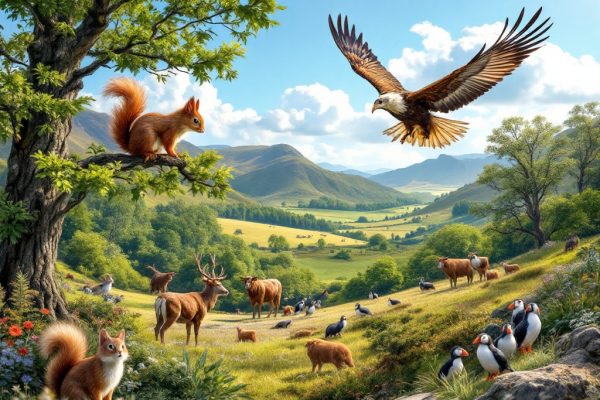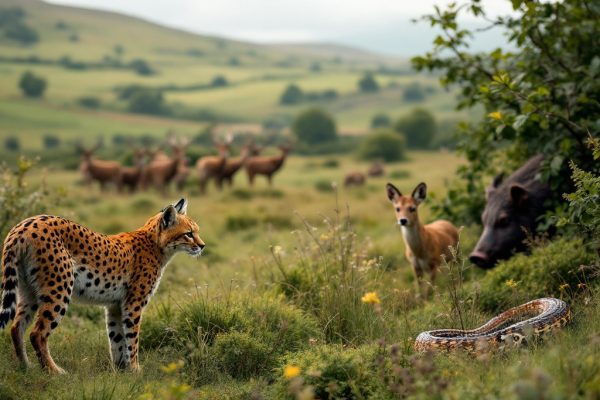Animals with Longest Tails in Lothian
Discover the fascinating world of Lothian’s longest-tailed creatures! From the agile red squirrel leaping through treetops to the cunning red fox using its bushy tail for communication, explore the vital roles these appendages play. Learn how tails up to 30 cm long help cats balance and how a lizard’s tail can be a life-saving decoy. Delve into the secrets of Lothian’s wildlife and uncover the evolutionary advantages of a long tail. Read on to explore this captivating aspect of Lothian’s fauna.
Important information

- Long tails help Lothian animals survive. They help with balance, escape, and communication.
- Red squirrels and foxes use their tails for balance and communication. Long-tailed tits use theirs for agile flight.
- Lizards, like the long-tailed grass lizard, can detach their tails to escape predators.
- Pine martens use bushy tails for balance in trees and warmth. Polecats use slender tails for hunting in burrows.
- Mink use their tails for swimming and balance on land.
Introduction to Animals with Longest Tails in Lothian
Lothian is home to a variety of creatures with impressively long tails. The red squirrel’s tail, for instance, nearly matches its body length and is essential for maintaining balance as it navigates the treetops. The red fox also possesses a long, bushy tail, used for both balance and communication. Similarly, domestic cats utilize their tails, which can grow up to 30 cm, for balance and expressing themselves. Birds also benefit from elongated tails. The long-tailed tit and Eurasian jay, for example, rely on their tails for agile flight. Even the common pipistrelle bat uses its extended tail to enhance aerial maneuvers. These tails serve vital functions, enabling these diverse animals to flourish in their environments.
Key Species with Long Tails in Lothian
Lothian is home to a variety of animals with remarkably long tails, each serving a unique purpose. The long-tailed grass lizard, for example, has a tail that constitutes two-thirds of its total length. Red foxes use their bushy tails, nearly as long as their bodies, for balance and communication. Similarly, red squirrels rely on their large tails for stability while navigating through trees. The aptly named long-tailed tit has a tail longer than its body, crucial for flight. Domestic cats, however, display varying tail lengths, some reaching up to 30 cm, aiding in balance. The common lizard also benefits from a long tail, sometimes exceeding its body length, using it for balance and escaping predators. The slow worm, a legless lizard, possesses a long, regenerative tail used for defense. Birds, like the Eurasian jay, depend on their long tails for stable flight. The European hare utilizes its tail for agility and quick escapes. Lastly, swallows are recognized for their elongated tail feathers, enabling impressive aerial maneuvers.
Mammals
- red fox: uses its bushy tail for balance and communication,
- red squirrel: relies on its large tail for stability in trees,
- domestic cat: varying tail lengths (up to 30 cm) for balance,
- european hare: uses its tail for agility and quick escapes.
Reptiles
- long-tailed grass lizard: tail makes up two-thirds of its total length,
- common lizard: long tail (sometimes exceeding body length) for balance and predator evasion,
- slow worm: long, regenerative tail employed for defense.
Birds
- long-tailed tit: tail longer than its body, essential for flight,
- eurasian jay: relies on its long tail for stable flight,
- swallow: elongated tail feathers enable impressive aerial acrobatics.
Long-tailed Grass Lizards
The long-tailed grass lizard possesses a remarkably long tail, often two to three times its body length, sometimes reaching a full foot. This impressive appendage serves two key functions: balance and defense. If a predator attacks, the lizard can detach its tail. The still-wiggling tail distracts the predator, allowing the lizard to escape. This remarkable adaptation is essential for the lizard’s survival.
Long-tailed Widowbirds
Native to Africa, not Lothian, long-tailed widowbirds are renowned for their extraordinarily long tails. Males use these striking plumes to attract females during courtship displays. Female preference for the longest tails indicates their crucial role in mate selection.
Ring-tailed Lemurs
Ring-tailed lemurs are highly social primates, and their iconic black and white ringed tails play a crucial role in their interactions. These tails not only provide balance as they navigate the treetops but also serve as important communication tools. Lemurs signal each other with tail movements and scent marking, allowing them to maintain vital social connections within their group. The ring-tailed lemur’s tail is vital for both physical and social well-being.
Long Tailed Duck
The long-tailed duck (Clangula hyemalis) is easily recognized by its strikingly long tail feathers, which provide remarkable aerial maneuverability. These elongated tail feathers also play a vital role in courtship rituals, helping the ducks attract potential partners. A long-distance migrant, this duck journeys between its breeding grounds and foraging areas, frequenting a variety of wetlands, from coastal regions to freshwater lakes.
Characteristics of Long-tailed Species in Lothian
Lothian offers a habitat to various species with remarkably long tails. The long-tailed grass lizard uses its tail for balance and to escape predators, thriving in the grasslands and heathlands. The long-tailed widowbird, also inhabiting these areas, displays impressive tail feathers during mating season. Though not found in Lothian, the ring-tailed lemur of Madagascar uses its striped tail for balance and communication. Lastly, the long-tailed duck, a winter visitor to Lothian’s coasts and lochs, depends on its tail for flight and attracting mates.
Long-tailed Grass Lizards: Adaptations and Habitats
Long-tailed grass lizards are remarkably balanced, using their lengthy tails to deftly navigate thick vegetation. This tail also provides a crucial defense mechanism. When grabbed by a predator, it detaches, allowing a swift escape and increasing the lizard’s survival odds.
Long-tailed Widowbirds: Mating Displays and Habitats
The male long-tailed widowbird’s most striking feature, its exceptionally long tail, plays a vital role in courtship rituals. These displays occur in open habitats such as savannas, grasslands, and reedbeds. Females select mates based on tail length. This preference makes a long tail essential for reproductive success.
Ring-tailed Lemurs: Social Behavior and Habitats
Ring-tailed lemurs are highly social primates that live in groups of 10 to 30 individuals, typically led by a dominant female. Their iconic ringed tails serve multiple purposes. They aid balance as the lemurs gracefully leap through the trees and act as vital communication tools. These lemurs use their tails for visual signaling and scent marking, even engaging in “stink fights” by wafting scent at rivals. These captivating creatures inhabit Madagascar’s diverse forests, ranging from dry deciduous forests to gallery and spiny forests.
Long Tailed Duck: Migration and Habitats
Long-tailed ducks are known for their impressive migrations over vast distances. Their signature long tail feathers are crucial for this, providing enhanced aerial control. These elongated tails aid in complex aerial maneuvers and increase stability, contributing to efficient long-distance flights. Coastal areas and open waters serve as critical habitats for these ducks during their migrations.
Other Notable Long-tailed Species in Lothian
Lothian offers diverse habitats that support a variety of fascinating wildlife.
Pine Martens
Pine martens thrive in Lothian’s woodlands. Their bushy tails are vital for balance as they navigate the treetops and provide essential warmth during harsh winters.
Polecats
While polecats can be found in woodlands, they are more frequently observed in Lothian’s grasslands. Their slender tails contribute to a streamlined profile, ideal for hunting in tight burrows and crevices.
Mink
Semi-aquatic mink prefer Lothian’s rivers and streams. Their long, tapered tails serve as powerful underwater propellers, aiding in both propulsion and steering, while also providing balance on land.
Pine Marten: Habitats and Tail Function
Pine martens thrive in a variety of woodland environments, including coniferous, deciduous, and mixed forests. Their impressive bushy tails, approximately two-thirds of their body length, are crucial for balance, allowing them to move effortlessly through the treetops. This arboreal agility enables them to climb, jump, and hunt with remarkable proficiency.
Polecat: Distribution and Tail Characteristics
The European polecat’s tail, measuring 13 to 21 cm, is crucial for communication and balance during climbing and movement. These adaptable animals inhabit diverse terrains like woodlands, grasslands, and coastal areas across mainland Britain. However, they are absent from central and northern Scotland.
Mink: Behavior and Tail Adaptations
The American mink’s remarkable agility is largely due to its long tail. This tail provides essential balance in the mink’s semi-aquatic habitats, such as rivers, streams, and marshes. In the water, the tail acts as a rudder, enabling quick turns and dives crucial for hunting fish and providing propulsion. On land, the tail is equally vital for balance while climbing and running. Subtle tail movements also communicate the mink’s mood and even its intentions.
Ecological Importance of Tail Length in Lothian
In Lothian, a long tail can be the key to survival, offering advantages to both predator and prey. The long-tailed grass lizard, for instance, uses its tail to distract predators, increasing its chances of a quick getaway. But predators benefit too. The pine marten’s long tail provides balance and agility, making it a more effective hunter. The red fox uses its tail for balance and communication, while the long-tailed tit relies on its tail for stable flight. A long tail is a valuable asset in the Lothian wilds.
Prey
- long-tailed grass lizard: uses its tail to distract predators, increasing its chances of escape.
Predator
- pine marten: its long tail provides balance and agility for effective hunting.
- red fox: uses its tail for balance and communication.
- long-tailed tit: relies on its tail for stable flight.
Role of Long Tails in Predator-Prey Dynamics
A long tail offers several survival advantages in the predator-prey relationship. One key benefit is its use as a decoy. For example, lizards can detach their still-wiggling tails, distracting the predator and allowing a quick escape. Balance is another advantage. A long tail enables quick turns and fast escapes, especially for tree-dwelling animals like squirrels and primates. Birds also use long tails for better flight control, allowing quick maneuvers to avoid predators.

















